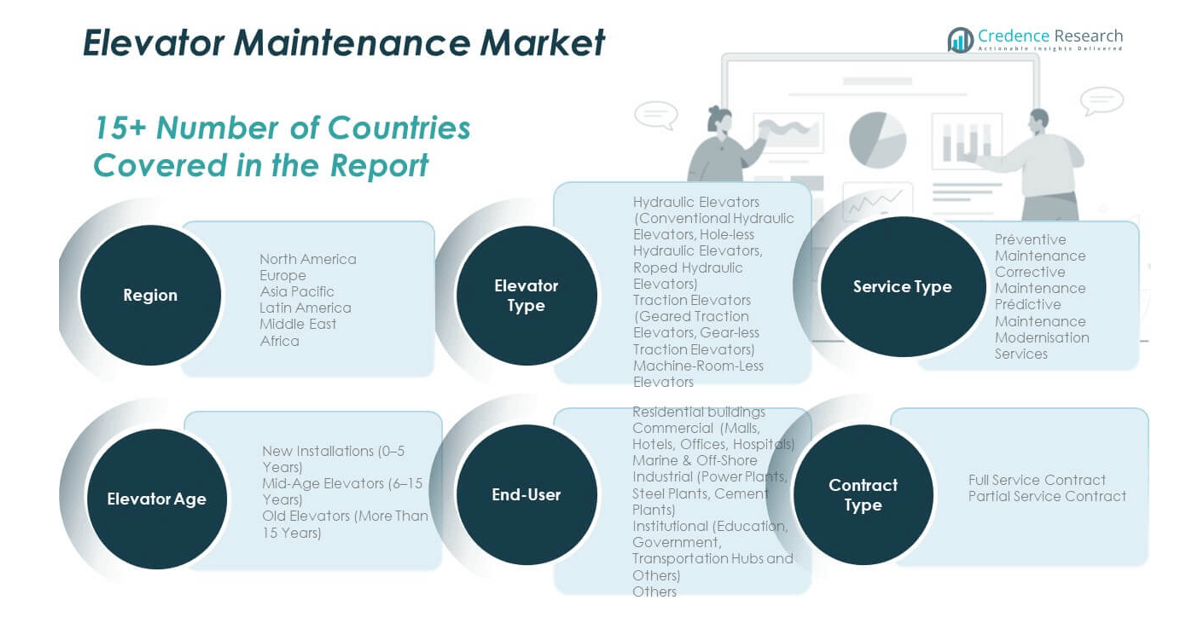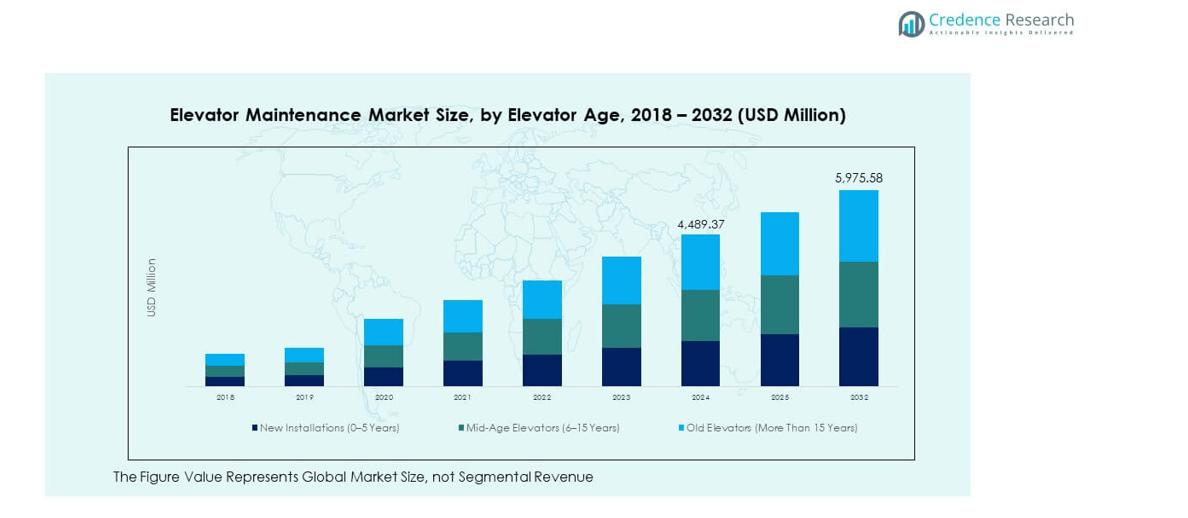CHAPTER NO. 1 : INTRODUCTION 22
1.1. Report Description 22
Purpose of the Report 22
USP & Key Offerings 22
1.2. Key Benefits for Stakeholders 23
1.3. Target Audience 23
CHAPTER NO. 2 : EXECUTIVE SUMMARY 24
CHAPTER NO. 3 : INDONESIA ELEVATOR MAINTENANCE MARKET FORCES & INDUSTRY PULSE 26
3.1. Foundations of Change – Market Overview 26
3.2. Catalysts of Expansion – Key Market Drivers 28
3.3. Momentum Boosters – Growth Triggers 29
3.4. Innovation Fuel – Disruptive Technologies 29
3.5. Headwinds & Crosswinds – Market Restraints 30
3.6. Regulatory Tides – Compliance Challenges 31
3.7. Economic Frictions – Inflationary Pressures 31
3.8. Untapped Horizons – Growth Potential & Opportunities and Strategic Navigation – Industry Frameworks 32
3.9. Market Equilibrium – Porter’s Five Forces 33
3.10. Macro Forces – PESTEL Breakdown 35
CHAPTER NO. 4 : COMPETITION ANALYSIS 37
4.1. Company Market Share Analysis 37
4.1.1. Indonesia Elevator Maintenance Market Company Revenue Market Share 37
4.2. Strategic Developments 39
4.2.1. Acquisitions & Mergers 39
4.2.2. New Product Type Launch 40
4.2.3. Agreements & Collaborations 41
4.3. Competitive Dashboard 42
4.4. Company Assessment Metrics, 2024 43
4.5. Market Prospects for Elevator Maintenance Services in Jakarta 44
4.6. Marketing Strategy Framework 44
4.7. Sales Strategy 45
CHAPTER NO. 5 : INDONESIA MARKET ANALYSIS, INSIGHTS & FORECAST, BY ELEVATOR TYPE 46
CHAPTER NO. 6 : INDONESIA MARKET ANALYSIS, INSIGHTS & FORECAST, BY SERVICE TYPE 50
CHAPTER NO. 7 : INDONESIA MARKET ANALYSIS, INSIGHTS & FORECAST, BY ELEVATOR AGE 54
CHAPTER NO. 8 : INDONESIA MARKET ANALYSIS, INSIGHTS & FORECAST, BY CONTRACT TYPE 58
CHAPTER NO. 9 : INDONESIA MARKET ANALYSIS, INSIGHTS & FORECAST, BY END-USER 62
CHAPTER NO. 10 : INDONESIA MARKET ANALYSIS, INSIGHTS & FORECAST, BY PROVIDER 66
CHAPTER NO. 11 : COMPANY PROFILE 70
11.1. Mitsubishi Electric Corporation 70
11.2. Hitachi Building Systems Co., Ltd. 73
11.3. Toshiba Elevator and Building Systems Corp 73
11.4. Schindler Japan K.K. 73
11.5. Otis Elevator Company (Japan) 73
11.6. PT Hyundai Elevator Indonesia (HELIN) 73
11.7. PT YASKAWA Elevator Indonesia 73
11.8. PT Berca Elevators & Escalators 73
11.9. PT Sigma Elevators 73
11.10. Company 10 73
11.11. Company 11 73
11.12. Company 12 73
11.13. Company 13 73
11.14. Company 14 73
List of Figures
FIG NO. 1. Indonesia Elevator Maintenance Market Revenue Share, By Elevator Type, 2024 & 2032 46
FIG NO. 2. Market Attractiveness Analysis, By Elevator Type 47
FIG NO. 3. Incremental Revenue Growth Opportunity by Elevator Type, 2024 – 2032 48
FIG NO. 4. Indonesia Elevator Maintenance Market Revenue Share, By Service Type, 2024 & 2032 50
FIG NO. 5. Market Attractiveness Analysis, By Service Type 51
FIG NO. 6. Incremental Revenue Growth Opportunity by Service Type, 2024 – 2032 52
FIG NO. 7. Indonesia Elevator Maintenance Market Revenue Share, By Elevator Age, 2024 & 2032 54
FIG NO. 8. Market Attractiveness Analysis, By Elevator Age 55
FIG NO. 9. Incremental Revenue Growth Opportunity by Elevator Age, 2024 – 2032 56
FIG NO. 10. Indonesia Elevator Maintenance Market Revenue Share, By Contract Type, 2024 & 2032 58
FIG NO. 11. Market Attractiveness Analysis, By Contract Type 59
FIG NO. 12. Incremental Revenue Growth Opportunity by Contract Type, 2024 – 2032 60
FIG NO. 13. Indonesia Elevator Maintenance Market Revenue Share, By End-user, 2024 & 2032 62
FIG NO. 14. Market Attractiveness Analysis, By End-user 63
FIG NO. 15. Incremental Revenue Growth Opportunity by End-user, 2024 – 2032 64
FIG NO. 16. Indonesia Elevator Maintenance Market Revenue Share, By Provider, 2024 & 2032 66
FIG NO. 17. Market Attractiveness Analysis, By Provider 67
FIG NO. 18. Incremental Revenue Growth Opportunity by Provider, 2024 – 2032 68
List of Tables
TABLE NO. 1. : Indonesia Elevator Maintenance Market Revenue, By Elevator Type, 2018 – 2024 (USD Million) 49
TABLE NO. 2. : Indonesia Elevator Maintenance Market Revenue, By Elevator Type, 2025 – 2032 (USD Million) 49
TABLE NO. 3. : Indonesia Elevator Maintenance Market Revenue, By Service Type, 2018 – 2024 (USD Million) 53
TABLE NO. 4. : Indonesia Elevator Maintenance Market Revenue, By Service Type, 2025 – 2032 (USD Million) 53
TABLE NO. 5. : Indonesia Elevator Maintenance Market Revenue, By Elevator Age, 2018 – 2024 (USD Million) 57
TABLE NO. 6. : Indonesia Elevator Maintenance Market Revenue, By Elevator Age, 2025 – 2032 (USD Million) 57
TABLE NO. 7. : Indonesia Elevator Maintenance Market Revenue, By Contract Type, 2018 – 2024 (USD Million) 61
TABLE NO. 8. : Indonesia Elevator Maintenance Market Revenue, By Contract Type, 2025 – 2032 (USD Million) 61
TABLE NO. 9. : Indonesia Elevator Maintenance Market Revenue, By End-user, 2018 – 2024 (USD Million) 65
TABLE NO. 10. : Indonesia Elevator Maintenance Market Revenue, By End-user, 2025 – 2032 (USD Million) 65
TABLE NO. 11. : Indonesia Elevator Maintenance Market Revenue, By Provider, 2018 – 2024 (USD Million) 69
TABLE NO. 12. : Indonesia Elevator Maintenance Market Revenue, By Provider, 2025 – 2032 (USD Million) 69










